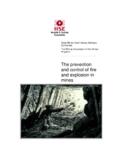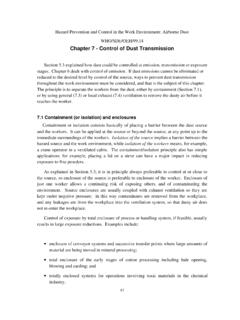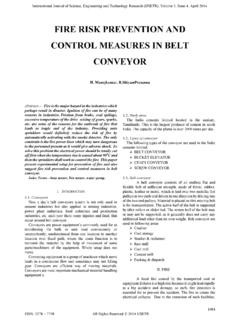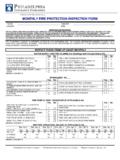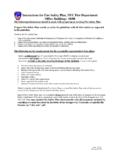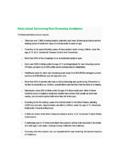Transcription of Guidance on the prevention and control of fire and ...
1 Guidance on the prevention and control of fire and explosion at mines used for storage and other purposes Contents: iii What this booklet is about ..4. Who should read this booklet? ..4. Legal framework ..4. Primary Provisions relating to worker protection ..4. Provisions relating to the supply of products ..6. fire and explosion Risk Introduction ..6. Risk Assessment ..6. Main Identifying the Evaluating the likelihood ..9. Deciding who might be harmed and Recording significant findings ..9. Reviewing the assessments ..10. Risk assessment and the emergency plan.
2 10. fire and explosion prevention and fire Protection and Emergency Plans ..13. fire protection plan ..13. The Emergency Plan ..13. fire avoidance and control measures ..13. Avoidance and control of sources of ignition ..13. Selection, and use of Machinery and equipment Inspection, testing and maintenance ..16. Naked lights/flame/hot Smoking and smoking materials ..17. control of flammable materials below fire resistant materials in structures above and below fire safety checks ..19. Detecting fires and raising the alarm ..19. Alarm systems ..21. Alarm levels ..21.
3 Testing and inspection ..22. Preventing the spread of fire ..22. fire resisting walls and doors ..22. Ventilation control ..23. fire When to fight fire -fighting measures ..24. Selection and fire On-board fire fighting systems ..25. Other fire suppression systems ..25. Inspection, testing and maintenance of Training ..26. Arrangements for Explosion Risk Assessment ..28. The risk of explosion ..28. i Explosion Assessing explosion risks ..29. Explosion Protection Explosion control measures ..31. Zoning ..31. APPENDIX ..32. Law relevant to fire and explosions ..32. Legislation of general application.
4 32. Legislation applying only to ii Introduction This information and Guidance was prepared, in consultation with the Health and Safety Executive (HSE), by a working group representative of the storage mine sector. It represents what members of the working group and HSE consider good practice. Members of the working group on the prevention and control of fire and explosion in mines used for storage and other purposes .. Mr S Ainsworth, Leafield Logistics and Technical Services Ltd Mr A Barker, Health and Safety Consultant Mr M J Barnard, Wansdyke Security Ltd Mr P Campbell, Deepstore Ltd Mr N R N Cullis, Wansdyke Security Ltd Mr L Fielding, Wiltshire fire Brigade Mr S Reece, Salt Union Ltd Mr J Turner, Octavian Ltd Mr R Wild, Wiltshire fire Brigade Mr S Denton, HM Inspectorate of Mines, Health and Safety Executive Mr JA Forster, HM Inspectorate of Mines, Health and Safety Executive iii What this booklet is about 1.
5 This Guidance is for mines and parts of mines used for the storage of materials, products or documents and for other non-producing mines used for other purposes. 2. It should be read in conjunction with the HSE/Home Office Guidance fire Safety, An Employer's Guide', ISBN 0-11-341229-0. This booklet contains additional Guidance addressing circumstances, both legal and technical, that are particular to operations carried on in mines used for other purposes. It will help mine owners and managers: Comply with the law;. Identify fire and explosion hazards and carry out fire and explosion risk assessments.
6 Identify the measures necessary to avoid, control and mitigate the risks;. Prepare fire and explosion protection plans. 3. These risk assessments will also help mine managers to prepare their emergency plans setting out the action to be taken to effect the evacuation and rescue of people from below ground in the event of a fire or explosion. Who should read this booklet? 4. It should be read by: Mine owners;. Mine managers;. Other mine staff who have a role in ensuring fire safety through supervision, inspection and maintenance etc;. Safety and employee representatives.
7 It can be used as a tool for training and refresher training. Legal framework Primary legislation 5. The two main pieces of primary legislation (Acts of Parliament) relevant to fire and explosion in mines are: The Mines and Quarries Act 1954, which includes provisions that have a bearing on fire and explosion. The Health and Safety at Work etc Act 1974, which contains duties relating to safe systems of work and ensuring the health and safety of employees and others who may be affected by a work activity. Provisions relating to worker protection 6. Beyond the general duties set out in primary legislation there are a number of legal provisions that collectively require employers/mine owners, and in some cases mine managers, to assess the likelihood of a fire or explosion, its nature and extent, and the numbers of people who would be put at risk: 4.
8 Regulation 3 of The Management of Health and Safety at Work Regulations 1999 requires all employers and self-employed people to assess the risks to workers and any others who may be affected by their work or business. That assessment must include the risks from fire and explosion hazards where they exist. Regulation 4 of The Mines Miscellaneous Health and Safety Provisions Regulations 1995 requires mine owners to produce a health and safety document that demonstrates that the risks to which people at work at the mine are exposed have been assessed in accordance with regulation 3 of The Management of Health and Safety at Work Regulations 1999.
9 In particular: o Regulation 4(1) requires that these plans must be based on a risk assessment, the outcome of which demonstrates that adequate measures concerning the design, use and maintenance of the mine and its equipment have, and will continue to be taken. The health and safety document must also set out how the measures will be co-ordinated, taking account of both normal and emergency situations. o Regulation 4(2)(a) and 4(5)(a) respectively require an explosion and fire protection plan to be included in the health and safety document. Regulation 4 of The Escape and Rescue from Mines Regulations 1995 requires managers to prepare and maintain a written plan (emergency plan) setting out the action to be taken to effect safely and promptly the evacuation and rescue of people from the mine should an emergency situation occur.
10 In preparing this plan, managers should take account of any relevant risk assessment made in accordance with regulation 3 of the Management of Health and Safety at Work Regulations 1999. The Provision and Use of Work Equipment Regulations 1998. impose requirements upon employers in respect of work equipment provided for or used by their employees at work. The requirements also apply to the self-employed and people in control of premises. The Dangerous Substances and Explosive Atmospheres Regulations 2002 apply to mines apart from the provisions of regulations 5(4)(c), 7 and 11.










